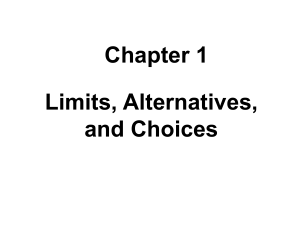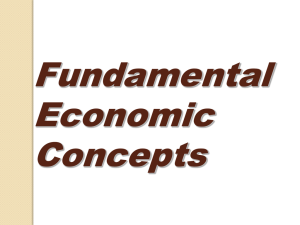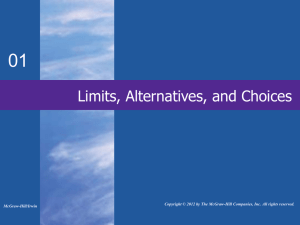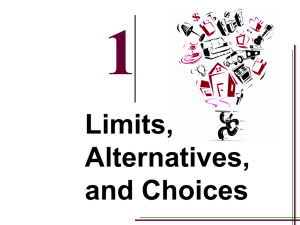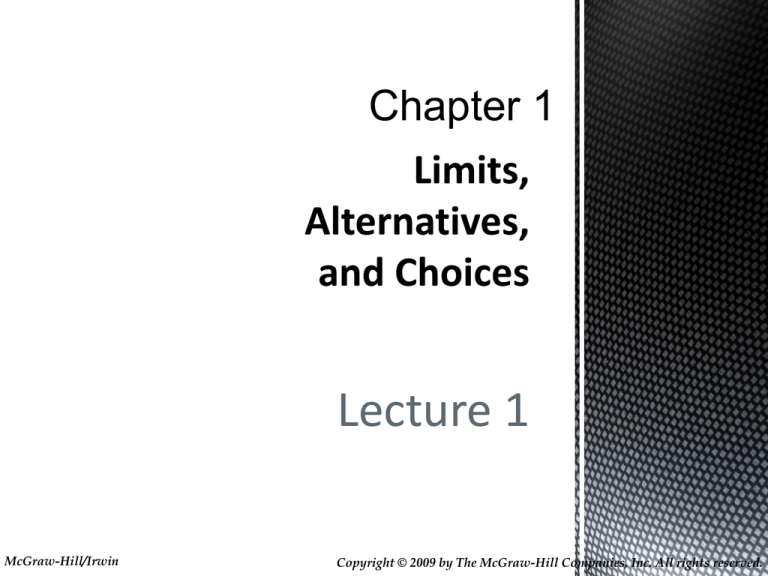
Chapter 1
Lecture 1
McGraw-Hill/Irwin
Copyright © 2009 by The McGraw-Hill Companies, Inc. All rights reserved.
Economics defined
Role of economic
theory
Microeconomics vs.
macroeconomics
Resource scarcity and
the economizing
problem
Production
possibilities model
1-2
Economic wants
exceed productive
capacity
Social science
concerned with
making optimal
choices under
conditions of scarcity
1-3
Thinking like an
economist
Key features:
Scarcity and
choice
Purposeful
behavior
Marginal analysis
1-4
Resources are
scarce
Choices must be
made
There is no free
lunch
Opportunity cost
1-5
Individuals seeks to
maximize their utility – the
pleasure or satisfaction
from consuming a good or
services.
Economic decisions are
“rational” or “purposeful”
because the costs and
benefits of the decision
are weighed.
Decisions are made with
some desired outcome in
mind
Firms and profit
1-6
Individuals compare the
marginal benefits and
marginal costs in making
economic decision.
Marginal means “extra” or
“additional”.
So long as marginal benefits
are greater than marginal
costs, we consume (or
produce) more.
When marginal costs
exceed marginal benefits,
we consume (or produce)
less.
1-7
Economics uses the same
scientific method:
Observing real-world behavior
and outcomes
Formulating a hypothesis or
possible explanation of cause
and effect,
Testing the hypothesis,
Accepting, rejecting, or
modifying the hypothesis, and
Continued testing of the
hypothesis against the facts,
evolving into a theory as
favorable results accumulate.
1-8
A very well tested and widely
accepted theory is called an
economic principle -- a statement
about economic behavior or the
economy that enables prediction
of the probable effects of certain
actions.
Economists develop theories of
the behavior of individuals
(consumers, workers) and
institutions (businesses,
governments) engaged in the
production, exchange and
consumption of goods and
services.
Economic principles and
models are
generalizations relating to
economic behavior or to
the economy itself,
incorporate the otherthings-equal-assumption
or ceteris paribus, and
are expressed graphically
Macroeconomics
Aggregate
Microeconomics
Individual Units
1-11
Both microeconomics and
macroeconomics contain
elements of positive
economics and normative
economics.
Positive economics focuses
on facts and cause-andeffect relationships – what
is
Normative economics
incorporate value
judgments about what the
economy should be like –
what ought to be
Limited income
Unlimited wants
A budget line
Tradeoffs &
opportunity costs
Make best choice
possible
Change in income
1-13
Budget Lines (constraints) depict the various
combinations of two products a consumer can purchase
with a specific money income.
$120 Budget
DVDs Books
$20
$10
6
5
4
3
2
1
0
0
2
4
6
8
10
12
1-14
All combinations on
or inside the
budget line are
attainable.
All combinations
beyond the budget
line are
unattainable.
A budget line
illustrates the idea of
tradeoffs arising from
limited income.
The budget line
illustrates those
choices that are
attainable.
The location of the
budget line varies
with money income.
Four general input categories: Scarce
resources
Land – includes natural resources
Labor – the physical and mental talents
of humans
Capital – manufactured aids such as tools
and factories
Entrepreneurial Ability – a specific
human resource distinct from labor
Factors of production
1-17
Illustrates the
resource constraints
we have at a societal
level.
Assumptions:
Full employment
Fixed resources
Fixed technology
Two goods
1-18
Production Possibilities Table
Lists the different combinations of two products
that can be produced with a specific set of
resources, assuming full employment.
1-19
Industrial Robots
A’
14
13
12
11
10
9
8
7
6
5
4
3
2
1
B’
Unattainable
A
Economic
Growth
C’
B
C
D’
D
Now Attainable
Attainable
E’
E
0
1
2
3
4
5
6
7
8 9
Pizzas
1-20
Industrial Robots
A’
14
13
12
11
10
9
8
7
6
5
4
3
2
1
B’
Unattainable
A
Law of Increasing
Opportunity Cost
C’
B
C
D’
Shape of
the Curve
D
Attainable
E’
E
0
1
2
3
4
5
6
7
8 9
Pizzas
1-21
Marginal Benefit & Marginal Cost
15
a
c
MC
MB = MC
e
10
5
b
d
MB
0
1
2
3
Quantity of Pizza
1-22
Scarce resources prohibit an
economy from having more
of both goods.
Attainable combinations lie
on or inside the production
possibilities curve.
When an economy is
operating on the curve,
moving from one point to
another represents an
opportunity cost – the
economy must sacrifices
some of one good to obtain
more of another.
The shape results in not only
incurring opportunity costs
as we move along the curve,
but also increasing
opportunity costs.
Because economic
resources are not
completely adaptable to
alternative uses, producing
an additional unit of one
good means giving up
successively larger amounts
of the other good.
For example,
point U
represents a
situation of
unemployment.
Industrial Robots
The economy is
producing at an
attainable, but
inefficient level.
A’
14
13
12
11
10
9
8
7
6
5
4
3
2
1
B’
Unattainable
C’
U
D’
Under or
Unemployment
E’
0
1
2
3
4
5
6
7
8 9
Pizzas
1-25
A Growing Economy
More resources
Better quality
resources
Technological
advances
1-26
Current
Curve
P
Goods for the Present
Presentville
Goods for the Future
Goods for the Future
Future
Curve
Future
Curve
F
Current
Curve
Goods for the Present
Futureville
1-27
International trade – can be a
qualifier to the production
possibilities curve constraints.
In later chapters we learn that
an economy can obtain more
goods and services than its
production possibilities curve
indicates through international
trade and specialization.
Expansion of domestic
production possibilities and
international trade are two
distinct ways for obtaining
greater output.
1-28
Biases and
preconceptions not
supported by facts,
loaded terminology
that may be
emotionally biased,
Fallacy of Composition
- a statement that is
true for an individual
or part is not
necessarily true for the
larger group or whole
1-29
Post Hoc Fallacy in which
the statement “because
event A precedes event B, A
is the cause of B” uses faulty
reasoning.
Correlation
but
not
causation - Correlation
between two events or two
sets of data indicates only
that they are associated in
some way, but correlation
does not mean that there is
causation.
economics
economic perspective
opportunity cost
utility
marginal analysis
scientific method
economic principle
other-things-equal
assumption
macroeconomics
aggregate
microeconomics
positive economics
normative economics
economizing problem
budget line
economic resources
land
labor
capital
investment
entrepreneurial ability
factors of production
consumer goods
capital goods
production possibilities curve
law of increasing opportunity
costs
economic growth
1-31
The Market
System and the
Circular Flow
1-32

